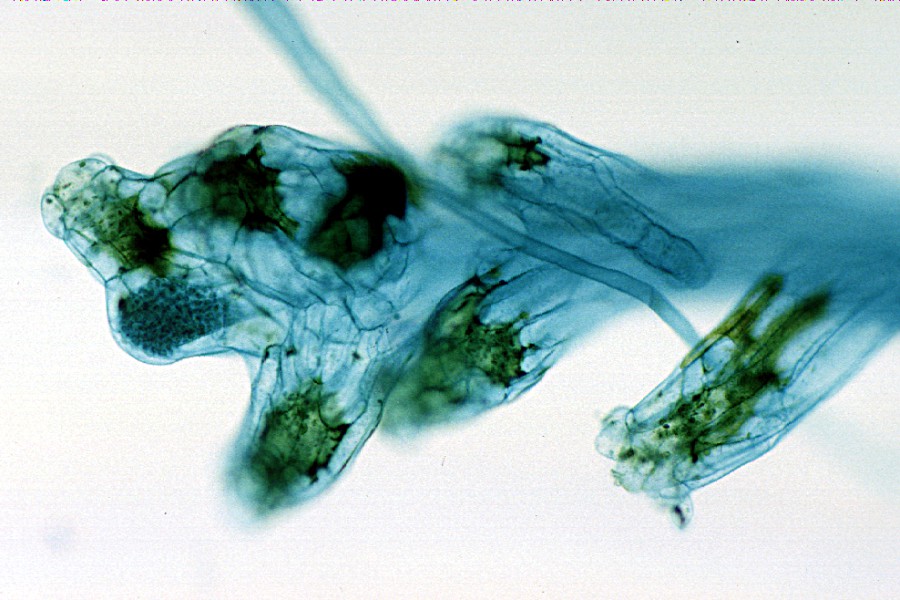Gametangium on:
[Wikipedia]
[Google]
[Amazon]
 A gametangium (: gametangia) is a
A gametangium (: gametangia) is a
 A gametangium (: gametangia) is a
A gametangium (: gametangia) is a sex organ
A sex organ, also known as a reproductive organ, is a part of an organism that is involved in sexual reproduction. Sex organs constitute the primary sex characteristics of an organism. Sex organs are responsible for producing and transporting ...
or cell in which gamete
A gamete ( ) is a Ploidy#Haploid and monoploid, haploid cell that fuses with another haploid cell during fertilization in organisms that Sexual reproduction, reproduce sexually. Gametes are an organism's reproductive cells, also referred to as s ...
s are produced that is found in many multicellular protist
A protist ( ) or protoctist is any eukaryotic organism that is not an animal, land plant, or fungus. Protists do not form a natural group, or clade, but are a paraphyletic grouping of all descendants of the last eukaryotic common ancest ...
s, algae
Algae ( , ; : alga ) is an informal term for any organisms of a large and diverse group of photosynthesis, photosynthetic organisms that are not plants, and includes species from multiple distinct clades. Such organisms range from unicellular ...
, fungi
A fungus (: fungi , , , or ; or funguses) is any member of the group of eukaryotic organisms that includes microorganisms such as yeasts and mold (fungus), molds, as well as the more familiar mushrooms. These organisms are classified as one ...
, and the gametophytes of plant
Plants are the eukaryotes that form the Kingdom (biology), kingdom Plantae; they are predominantly Photosynthesis, photosynthetic. This means that they obtain their energy from sunlight, using chloroplasts derived from endosymbiosis with c ...
s. In contrast to gametogenesis in animal
Animals are multicellular, eukaryotic organisms in the Biology, biological Kingdom (biology), kingdom Animalia (). With few exceptions, animals heterotroph, consume organic material, Cellular respiration#Aerobic respiration, breathe oxygen, ...
s, a gametangium is a haploid structure and formation of gametes does not involve meiosis.
Types of gametangia
Depending on the type of gamete produced in a gametangium, several types can be distinguished.Female
Female gametangia are most commonly called archegonia. They produceegg cell
The egg cell or ovum (: ova) is the female Reproduction, reproductive cell, or gamete, in most anisogamous organisms (organisms that reproduce sexually with a larger, female gamete and a smaller, male one). The term is used when the female game ...
s and are the sites for fertilization
Fertilisation or fertilization (see American and British English spelling differences#-ise, -ize (-isation, -ization), spelling differences), also known as generative fertilisation, syngamy and impregnation, is the fusion of gametes to give ...
. Archegonia are common in algae and primitive plants as well as gymnosperms. In flowering plant
Flowering plants are plants that bear flowers and fruits, and form the clade Angiospermae (). The term angiosperm is derived from the Ancient Greek, Greek words (; 'container, vessel') and (; 'seed'), meaning that the seeds are enclosed with ...
s, they are replaced by the embryo sac inside the ovule
In seed plants, the ovule is the structure that gives rise to and contains the female reproductive cells. It consists of three parts: the ''integument'', forming its outer layer, the ''nucellus'' (or remnant of the sporangium, megasporangium), ...
.
Male
The male gametangia are most commonly called antheridia. They produce sperm cells that they release for fertilization. Antheridia producing non-motile sperm (spermatia) are called spermatangia. Some antheridia do not release their sperm. For example, the oomycete antheridium is a syncytium with many sperm nuclei and fertilization occurs via fertilization tubes growing from the antheridium and making contact with the egg cells. Antheridia are common in the gametophytes in "lower" plants such asbryophyte
Bryophytes () are a group of embryophyte, land plants (embryophytes), sometimes treated as a taxonomic Division (taxonomy), division referred to as Bryophyta ''Sensu#Common qualifiers, sensu lato'', that contains three groups of non-vascular pla ...
s, fern
The ferns (Polypodiopsida or Polypodiophyta) are a group of vascular plants (plants with xylem and phloem) that reproduce via spores and have neither seeds nor flowers. They differ from mosses by being vascular, i.e., having specialized tissue ...
s, cycads and ginkgo
''Ginkgo'' is a genus of non-flowering seed plants, assigned to the gymnosperms. The scientific name is also used as the English common name. The order to which the genus belongs, Ginkgoales, first appeared in the Permian, , and ''Ginkgo'' is n ...
. In "higher" plants such as conifer
Conifers () are a group of conifer cone, cone-bearing Spermatophyte, seed plants, a subset of gymnosperms. Scientifically, they make up the phylum, division Pinophyta (), also known as Coniferophyta () or Coniferae. The division contains a sin ...
s and flowering plants, they are replaced by pollen grains.
Isogamous
Inisogamy
Isogamy is a form of sexual reproduction that involves Gamete, gametes of the same Morphology (biology), morphology (indistinguishable in shape and size), and is found in most Unicellular organism, unicellular eukaryotes. Because both gametes lo ...
, the gametes look alike and cannot be classified into "male" or "female." For example, in zygomycetes, two gametangia (single multinucleate cells at the end of hyphae) form good contact with each other and fuse into a zygosporangium. Inside the zygosporangium, the nuclei from each of the original two gametangia pair up.{{clarification needed, reason=to what end?, date=July 2021
See also
* Zoosporangium, a gametangium that produces motile isogamous gametes, called zoosporesReferences